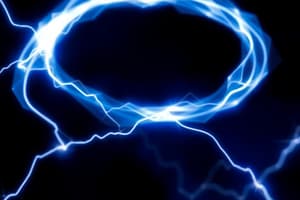Podcast
Questions and Answers
What does the symbol $
ho$ represent in the equation $dq =
ho dV$?
What does the symbol $ ho$ represent in the equation $dq = ho dV$?
- Electric potential
- Volume charge density (correct)
- Electric field intensity
- Net force on charge
The electric field intensity is a scalar quantity.
The electric field intensity is a scalar quantity.
False (B)
What is the SI unit of electric field intensity?
What is the SI unit of electric field intensity?
N/C
If $q > 0$, the electric field direction is _____ the source charge.
If $q > 0$, the electric field direction is _____ the source charge.
Match the following concepts with their definitions:
Match the following concepts with their definitions:
In which orientation is an electric dipole in stable equilibrium?
In which orientation is an electric dipole in stable equilibrium?
The net electric flux emerging from a closed surface enclosing a net charge is zero when the algebraic sum of charges is zero.
The net electric flux emerging from a closed surface enclosing a net charge is zero when the algebraic sum of charges is zero.
What is the formula for the electric field due to a thin, infinitely long straight wire of uniform linear charge density λ at a distance r?
What is the formula for the electric field due to a thin, infinitely long straight wire of uniform linear charge density λ at a distance r?
For a uniformly charged thin spherical shell at a point outside the shell (r > R), the electric field is given by E = __________.
For a uniformly charged thin spherical shell at a point outside the shell (r > R), the electric field is given by E = __________.
Match the following Gaussian surfaces with their corresponding shapes:
Match the following Gaussian surfaces with their corresponding shapes:
What does Millikan's oil drop experiment demonstrate?
What does Millikan's oil drop experiment demonstrate?
The net charge in an isolated system can change over time.
The net charge in an isolated system can change over time.
What is the formula for Coulomb's law?
What is the formula for Coulomb's law?
The total charge of a system is the _________ sum of its individual charges.
The total charge of a system is the _________ sum of its individual charges.
Which of the following statements is true about electric field intensity?
Which of the following statements is true about electric field intensity?
Match the types of charge distribution with their definitions:
Match the types of charge distribution with their definitions:
Electric charge is invariant and depends on the motion of the observer.
Electric charge is invariant and depends on the motion of the observer.
In continuous charge distribution, $dq$ for a surface is defined as $dq = _______ dS$.
In continuous charge distribution, $dq$ for a surface is defined as $dq = _______ dS$.
Flashcards are hidden until you start studying
Study Notes
Millikan's Oil Drop Experiment
- Demonstrated the quantized nature of electric charge.
- Established that charge exists in whole multiples of elementary charge (e), prohibiting fractional charges.
Conservation of Charge
- The total charge in an isolated system is constant over time.
- Charge can only be transferred, not created or destroyed.
Electric Charge Properties
- Electric charge is additive, determined by the algebraic sum of individual charges.
- Charge remains invariant, independent of motion or observation.
Coulomb's Law
- Describes the electrostatic force between two point charges: $$F = \frac{1}{4\pi\epsilon_0} \frac{q_1q_2}{r^2}$$
- $F$ is the force between charges $q_1$ and $q_2$, separated by distance r.
- $\epsilon_0$ (permittivity of free space) is approximately $8.85 \times 10^{-12} \text{ C}^2/\text{N m}^2$ or $9 \times 10^{9} \text{ Nm}^2/\text{C}^2$ in inverse form.
- In a medium, $\epsilon_0$ changes to $\epsilon_0 \epsilon_r$ (dielectric constant).
Continuous Charge Distribution Types
- Charge can distribute continuously in three ways:
- Linear Charge Distribution
- Surface Charge Distribution
- Volume Charge Distribution
Linear Charge Distribution
- Linearly distributed charge expressed as: $$dq = \lambda dl$$
- Forces calculated via: $$dF = \frac{1}{4\pi\epsilon_0} \frac{q_0\lambda dl}{r^2}$$
- Net force on charge $q_0$: $$F = \frac{q_0\lambda}{4\pi\epsilon_0} \int \frac{dl}{r^2}$$
Surface Charge Distribution
- Surface charge density expressed as: $$dq = \sigma dS$$
- Total force on charge $q_0$: $$F = \frac{q_0}{4\pi\epsilon_0} \int \frac{\sigma dS}{r^2}$$
Volume Charge Distribution
- Volume charge density represented as: $$dq = \rho dV$$
Electric Field Intensity
- Defined as electric force per unit positive charge: $$E = \lim_{q_0 \to 0} \frac{F}{q_0}$$
- SI units are N/C or V/m; it's a vector quantity.
Electric Field Intensity Due to a Point Charge
- Given by: $$E = \frac{1}{4\pi\epsilon_0} \frac{q}{r^2}$$
- For a positive charge, field lines point radially outward; for a negative charge, they point inward.
Electric Dipole in Uniform Electric Field
- Dipole orientation impacts stability; parallel alignment is stable, while antiparallel is unstable.
Gauss's Law
- Relates electric flux through a closed surface to the enclosed charge: $$\oint \vec{E} \cdot \vec{dA} = \frac{q}{\epsilon_{0}}$$
- Specific Gaussian surface shapes depend on charge configurations (spherical, cylindrical, etc.).
Electric Field Due to Specific Charge Distributions
- Thin, infinitely long straight wire: $$E = \frac{\lambda}{2\pi\epsilon_{0}r}$$
- Uniformly charged thin spherical shell:
- Outside shell ($r>R$): $$E = \frac{1}{4\pi\epsilon_0}\frac{q}{r^{2}}$$
- On the shell ($r=R$): $$E = \frac{1}{4\pi\epsilon_0}\frac{q}{R^{2}}$$
- Inside shell ($r<R$): Field intensity is zero.
Studying That Suits You
Use AI to generate personalized quizzes and flashcards to suit your learning preferences.




